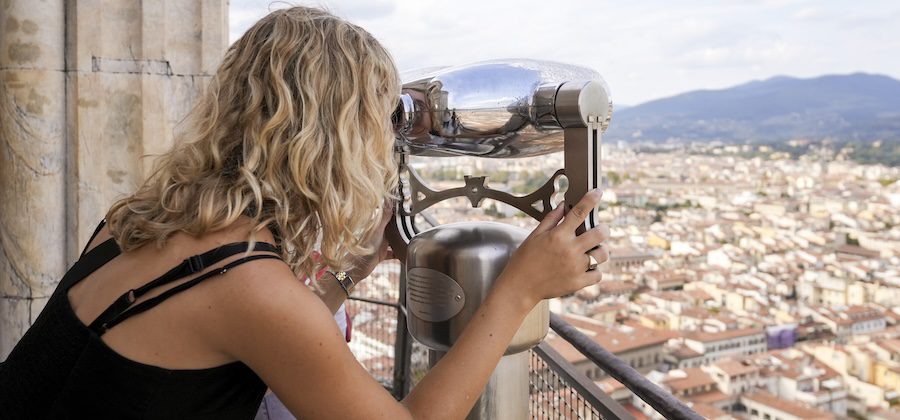If you’re heading to Florence, Italy, you cannot miss the city’s most iconic architectural wonder and popular attraction—the Florence Duomo. In this guide, you’ll learn the history behind Florence’s big red dome as well as how to see this beautiful Florence cathedral.
Pro Tip: Planning what to do on your trip to Florence? Bookmark this post in your browser so you can easily find it when you need it. Check out our guide to Florence for more planning resources, our best Florence Dome Climb tours, and how to visit the Florence “Il Duomo” Cathedral.
How To See the Duomo of Florence
The Florence Duomo, officially known as the Cattedrale di Santa Maria del Fiore, is a symbolic and artistic landmark of the city. As one of the largest churches in the 15th century, the Duomo’s historic display of wealth and prominence overshadowed cathedrals in surrounding cities. However, the story of its construction exceeds the lifetime of its creators.
Today, the Florence Duomo is one of the most popular attractions in Florence. In this guide, you’ll learn the history behind Florence’s big red dome as well as how to see the Florence Duomo.
How To Visit the Florence Duomo
Explore the Interior
Looking to get a glimpse inside Florence’s top attraction? As you enter the Duomo, you will immediately notice its beautiful Gothic architecture. With its vertical emphasis and ribbed vault, the Duomo’s size will surely shock you.
Climb To the Top
Climbing the 10 stories to the top of the Duomo is an experience of a lifetime. As one of the largest masonry cathedrals in Europe, the breathtaking view overlooks the entire city of Florence and beyond. There’s no view like it from any structure in the city. With no elevator, the 463-step climb gives you an up-close look at the Duomo ceiling and the surrounding marble, sandstone, and brick. The trek is worth its weight in gold.
It’s quite a climb to the top, but you must get the view if you can.
Francesca, Florence Guide
Not ready to book a tour? Explore our article on the best Florence tours to take and why.
The History of the Construction of the Duomo
Until 1412, Florence’s main cathedral was the Santa Reparata. It had provided the city with centuries of religious practice and historical support. The replacement, however, would emphasise the expansion of Florence’s prominence throughout Italy. Arnolfo di Cambio, the Duomo’s designer, began construction on September 8, 1296, when he laid the first panel of white marble with accents of green and red. Remains from the Santa Reparata are visible in the crypt of the Duomo.
At the time, Cambio was well-known in Siena for his contribution to the marble pulpit in their cathedral. He trained with Nicola Pisano to master architectural techniques until he began his own work. Other famous landmarks of his include monuments in Rome, Perugia, and, most importantly, Florence.
Although Cambio began construction in 1296, the completion of the Duomo wouldn’t be seen for over 140 years. The concept of enclosing the rooftop of the Duomo was too advanced for the late 13th century because Florentines lacked the technology to construct a dome of that diameter. Despite this major flaw in Cambio’s design, the Duomo’s construction proceeded.
You must imagine…nothing like this had ever been attempted before.
Francesca, Florence Guide
The Competition
Eighty years into building the Duomo, they still hadn’t uncovered the technology for the cupola. So, the Opera di Santa Maria del Fiore ran a competition in Florence to welcome the designs of engineering and architectural geniuses. One architect, Filippo Brunelleschi, won the competition for his keen knowledge of physics, geometry, and structural design.
He presented a plan that provided inner and outer shells with spaces in between to keep the space intact. Although this structural foundation is an indispensable facet of modern buildings, his unprecedented design was originally frowned upon by scholars and architects alike.
Brunelleschi and the Egg
It wasn’t until Brunelleschi presented an egg that the judges accepted his idea. Because his idea was new, he had no physical evidence to prove that the building would stand on its own, especially at such a massive size. Determined to prove himself and his work to the judges, he met with them and brought one tool: an egg.
He made all the judges attempt to stand an egg upright on the table. If you think it’s impossible to do, you’ll understand the judges’ frustration at the time. After all the judges tried, Brunelleschi grabbed the egg and smashed it on the table, which allowed it to stand perfectly upright.
At first, the judges laughed. They claimed they could’ve replicated his childish antics if they had known they could break the egg. However, Brunelleschi insisted that not one of them came up with the idea. After this thought, the judges approved his designs.
The Ceiling of the Duomo
The Duomo’s ceiling conveys intricate details and years of artistry paralleling that of the outside. The Grand Duke, Cosimo I de’ Medici, commissioned two artists by the names of Giorgio Vasari and Federico Zuccari to paint the ceiling of the octagonal dome.
Taking inspiration from Dante’s “Divine Comedy” and mirroring the mosaics in Florence’s Baptistery, the artists portrayed the Last Judgment. Eight groups of figures were depicted in the scene within six circular rows of the dome to ensure that the cycle of religious events could easily be portrayed. These mosaics remain one of the most prominent features of the Duomo itself, and many gather to learn the story for themselves.
Florence Duomo Tours
Not ready to book a tour? Check out our Florence Guide for more info.


